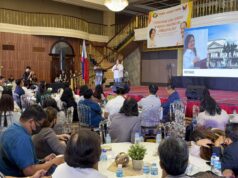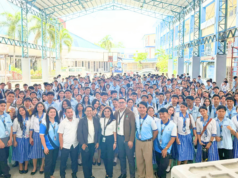ANGELES CITY- President Arroyo did not mention it during her last state-of-the-nation address (SONA), but her order in 2006 to crush insurgency is on track and will be achieved before her term ends next year, the Armed Forces’ Northern Luzon Command (Nolcom) said.
“There are now only about 1,000 armed members of the New People’s Army (NPA) in northern Luzon and we can’t even say they are insurgents,” newly promoted Nolcom spokesperson Lt. Col. Rosendo Armas told Punto.
“We are on the track towards the 2010 target. The rebels are on the run,” he said, although he admitted that some rebels have merely moved to other parts of the country.
Nolcom covers four regions, including Central Luzon, the Ilocos region, the Cagayan Valley region, and the Cordillera administrative region.
Armas said that the 1,000 armed rebels are spread in various parts of northern Luzon, but mostly in the mountain ranges of the Sierra Madre in the area of Aurora province where the rebels are allegedly being flushed out by soldiers from the 42nd Infantry Battalion of the 7th Infantry Division based in nearby Nueva Ecija.
“The recent discovery of buried arms cache, particularly in Bulacan, is one indication that the manpower of the NPA’s has significantly fizzled out. They had to bury arms because they do not have enough people to carry them,” Armas said.
When Lt. Gen. Victor Ibrado assumed post last May as the new Armed Forces chief, he also expressed confidence that the military would be able to beat the 2010 deadline imposed by the President to crush the 40-year-old communist insurgency.
In his first day on the job as chief of staff, Ibrado called on government agencies to back the “holistic” approach to defeat the NPA, but admitted that the task of crushing it finally was “overwhelming”.
In 2006, Arroyo ordered the military to end the Maoist insurgency by the time she steps down next year. In August last year, she reiterated this, and also told the military to likewise end Muslim secessionism before she steps down. She said that efforts towards these objectives would be funded from the P5-billion modernization fund for the Armed Forces.
Armas said that in a way, communist insurgency has already virtually ceased to exist in Nolcom provinces since most of the communist rebels have become “mere bandits engaged in extortion and other forms of criminality”.
“They have downgraded their guerilla fronts and they have merged their Samahang Platun units,” he added.
Last May, Prof. Philip Alston, the United Nation’s special rapporteur on extrajudicial, summary or arbitrary executions, made a follow up report to the UN Human Rights Council (UNCHR) saying that counterinsurgency operations in the country have led to extra-judicial killings.
Alston was in the country in 2007 to investigate spate of killings, including those reported in provinces covered by the Nolcom.
In his initial report to the UNHRC in April this year, Alston said that the President’s order to end insurgency by the end of her term has been “used to justify vilification of civil society organizations.”
“There are now only about 1,000 armed members of the New People’s Army (NPA) in northern Luzon and we can’t even say they are insurgents,” newly promoted Nolcom spokesperson Lt. Col. Rosendo Armas told Punto.
“We are on the track towards the 2010 target. The rebels are on the run,” he said, although he admitted that some rebels have merely moved to other parts of the country.
Nolcom covers four regions, including Central Luzon, the Ilocos region, the Cagayan Valley region, and the Cordillera administrative region.
Armas said that the 1,000 armed rebels are spread in various parts of northern Luzon, but mostly in the mountain ranges of the Sierra Madre in the area of Aurora province where the rebels are allegedly being flushed out by soldiers from the 42nd Infantry Battalion of the 7th Infantry Division based in nearby Nueva Ecija.
“The recent discovery of buried arms cache, particularly in Bulacan, is one indication that the manpower of the NPA’s has significantly fizzled out. They had to bury arms because they do not have enough people to carry them,” Armas said.
When Lt. Gen. Victor Ibrado assumed post last May as the new Armed Forces chief, he also expressed confidence that the military would be able to beat the 2010 deadline imposed by the President to crush the 40-year-old communist insurgency.
In his first day on the job as chief of staff, Ibrado called on government agencies to back the “holistic” approach to defeat the NPA, but admitted that the task of crushing it finally was “overwhelming”.
In 2006, Arroyo ordered the military to end the Maoist insurgency by the time she steps down next year. In August last year, she reiterated this, and also told the military to likewise end Muslim secessionism before she steps down. She said that efforts towards these objectives would be funded from the P5-billion modernization fund for the Armed Forces.
Armas said that in a way, communist insurgency has already virtually ceased to exist in Nolcom provinces since most of the communist rebels have become “mere bandits engaged in extortion and other forms of criminality”.
“They have downgraded their guerilla fronts and they have merged their Samahang Platun units,” he added.
Last May, Prof. Philip Alston, the United Nation’s special rapporteur on extrajudicial, summary or arbitrary executions, made a follow up report to the UN Human Rights Council (UNCHR) saying that counterinsurgency operations in the country have led to extra-judicial killings.
Alston was in the country in 2007 to investigate spate of killings, including those reported in provinces covered by the Nolcom.
In his initial report to the UNHRC in April this year, Alston said that the President’s order to end insurgency by the end of her term has been “used to justify vilification of civil society organizations.”




